Trains Pt. 3
On the way home, I decided to stop in Paris for a day. I had some buildings and an M/M Paris retrospective to see.
The posters at the Tokyo Palais were so big. I told the lady at the desk this, she looked at me funny. I hadn't spoken to anybody for a day (strangers on trains? No.) My embarrassment was saved when she enthused "you're so (oooo) lucky to be living in the centre of the cultural world." Anyway. I don't really think that the 'Translate' project was necessary; surely M/M are established and flamboyant enough to exhibit everything without context props. As much as Dakis Joannou's collection seems decent and contemporary, I don't want or need the likes of Chris Ofili getting in the way of the Alphabet. (I could have kneeled down in front of the Alphabet):
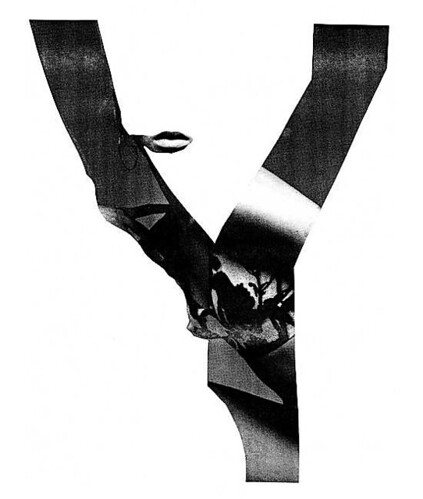

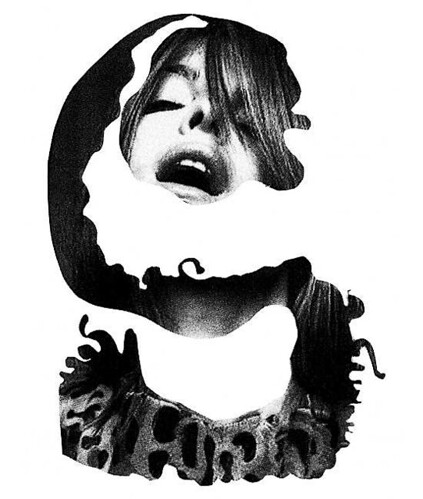
Carsten Nicolai had some words on the wall as part of the Utopia Station project, about the "open source ideal" of alternative power sources based on the transformation of sound into light. Something about liquid immersed bubbles emitting light, excited by sound. He calls it 'Sonic Lumiere', the scientists Frenzel and Shultes called it low density sound waves (it was 1934). The poster was pretty. (In the centre of the floor of this room were dozens of grimy conceptual pushchairs. Like Lewisham Centre's playground come 3.30, only dirtier. Unnecessary.)
So, I stuck about feeling screen prints until midnight, for the sum of 1 € (at last, an 'art student' perk.) Not that I'm romantic, but you could see the Eiffel Tower sparkling, and throw things at fire-breathing youths on the lower marbled levels, from the Tokyo Palais' outdoor foyer.
Earlier in the week, as part of their series of reinterpreted works, Nicolai had this great restored subharchord on show at the Kunstler Archiv in Berlin. He used a system designed by Werner Meyer-Eppler to produce b+w interference patterns based on the sounds. It was called subvision. Shame this space was located so near to the ladies'. They are noisy, ladies.
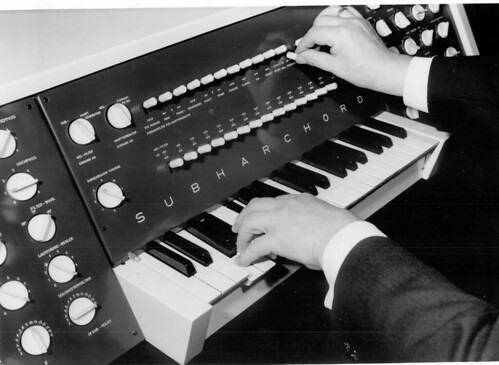
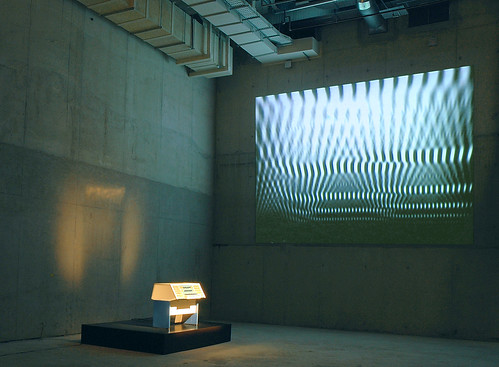
The last morning of my holiday I took part in a self-imposed 5-hour cross-arrondissement challenge. Frank Gehry, Henri Ciriani, Pierre Granveaud and Philippe Gazeaux all make good, if disparately located buildings. I rushed around, allowing two hours for Le Corbusier's villas. The proposed peak of the tour toppled under the puffy-lipped realisation (I enlisted a local orange dog-walker for aid) that the gated square with the Corbusier foundation inside, is closed on Sundays. It was pretty sad. Ciriani's St. Antoine hospital kitchen, located on a grubby street with an above-average laundrette quotidient, looks like this:
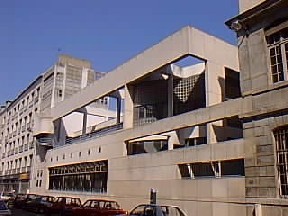
The posters at the Tokyo Palais were so big. I told the lady at the desk this, she looked at me funny. I hadn't spoken to anybody for a day (strangers on trains? No.) My embarrassment was saved when she enthused "you're so (oooo) lucky to be living in the centre of the cultural world." Anyway. I don't really think that the 'Translate' project was necessary; surely M/M are established and flamboyant enough to exhibit everything without context props. As much as Dakis Joannou's collection seems decent and contemporary, I don't want or need the likes of Chris Ofili getting in the way of the Alphabet. (I could have kneeled down in front of the Alphabet):



Carsten Nicolai had some words on the wall as part of the Utopia Station project, about the "open source ideal" of alternative power sources based on the transformation of sound into light. Something about liquid immersed bubbles emitting light, excited by sound. He calls it 'Sonic Lumiere', the scientists Frenzel and Shultes called it low density sound waves (it was 1934). The poster was pretty. (In the centre of the floor of this room were dozens of grimy conceptual pushchairs. Like Lewisham Centre's playground come 3.30, only dirtier. Unnecessary.)
So, I stuck about feeling screen prints until midnight, for the sum of 1 € (at last, an 'art student' perk.) Not that I'm romantic, but you could see the Eiffel Tower sparkling, and throw things at fire-breathing youths on the lower marbled levels, from the Tokyo Palais' outdoor foyer.
Earlier in the week, as part of their series of reinterpreted works, Nicolai had this great restored subharchord on show at the Kunstler Archiv in Berlin. He used a system designed by Werner Meyer-Eppler to produce b+w interference patterns based on the sounds. It was called subvision. Shame this space was located so near to the ladies'. They are noisy, ladies.


The last morning of my holiday I took part in a self-imposed 5-hour cross-arrondissement challenge. Frank Gehry, Henri Ciriani, Pierre Granveaud and Philippe Gazeaux all make good, if disparately located buildings. I rushed around, allowing two hours for Le Corbusier's villas. The proposed peak of the tour toppled under the puffy-lipped realisation (I enlisted a local orange dog-walker for aid) that the gated square with the Corbusier foundation inside, is closed on Sundays. It was pretty sad. Ciriani's St. Antoine hospital kitchen, located on a grubby street with an above-average laundrette quotidient, looks like this:


0 Comments:
Post a Comment
<< Home